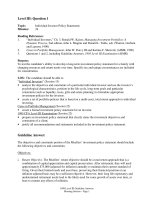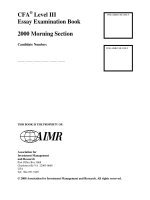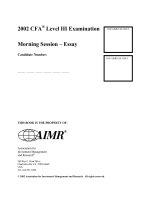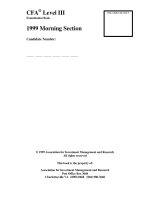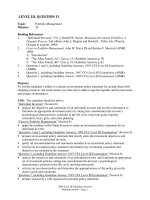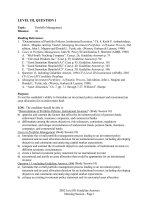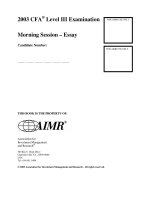L3 mock sample exam CFA level III guideline answers 1999
Bạn đang xem bản rút gọn của tài liệu. Xem và tải ngay bản đầy đủ của tài liệu tại đây (97.44 KB, 43 trang )
CFA® Level III
FOR AIMR USE ONLY
Examination Book
1999 Morning Section
Candidate Number:
_____ _____ _____ _____ _____ _____
© 1999 Association for Investment Management and Research
All rights reserved
This book is the property of:
Association for Investment Management and Research
Post Office Box 3668
Charlottesville VA 22903-0668 (804) 980-3668
The following list contains the command words used on the Morning Section of
the 1999 Level III Examination. Candidates may want to refer to this list as they
formulate their answers.
calculate:
To ascertain or determine by mathematical processes.
compare:
To examine the character or qualities of for the purpose of discovering,
primarily, resemblances.
construct:
To create by organizing ideas or concepts logically and coherently.
critique:
To offer a critical review or commentary; to criticize.
describe:
To transmit a mental image, an impression, or an understanding of the nature
and characteristics of.
determine:
To come to a decision as the result of investigation or reasoning; to settle or
decide by choice among alternatives or possibilities.
discuss:
To discourse about through reasoning or argument; to present in detail.
evaluate:
To determine or fix the value of; to determine the significance or worth of,
usually by careful appraisal and study.
formulate:
To put into a systematized statement or expression; to prepare according to a
formula.
identify:
To establish the identity of; to show or prove the sameness of.
justify:
To prove or show to be valid, sound, or conforming to fact or reason; to
furnish grounds or evidence for.
list:
To enumerate.
select:
To choose from a number or group—usually, by fitness, excellence, or other
distinguishing feature.
show:
To set forth in a statement, account, or description; to make evident or clear.
state:
To express in words.
The Morning Section of the 1999 CFA Level III Examination has 11 questions.
For grading purposes, the maximum point value for each question is equal to the
number of minutes allocated to that question.
Question
1
2
3
4
5
6
7
8
9
10
11
Topic
Portfolio Management
Portfolio Management
Portfolio Management
Portfolio Management
Portfolio Management
Portfolio Management
Portfolio Management
Economics
Global Markets and Instruments
Ethics
Ethics
Total
Minutes
24
6
12
16
24
33
15
12
18
6
14
180
Questions 1 through 5 relate to Peter and Andrea Mueller, individual investors. A total
of 82 minutes is allocated to these questions. Use the first few minutes to review the
Introduction below. Candidates should answer these questions in the order presented.
INTRODUCTION
Peter and Andrea Mueller, U.S. residents, are reviewing their financial plan. The Muellers, both
age 53, have one daughter, age 18. With their combined after-tax salaries totaling $100,000 a
year, they are able to meet their living expenses and save $25,000 after taxes annually. They
expect little change in either their incomes or expenses on an inflation-adjusted basis other than
the addition of their daughter’s college expenses. Their only long-term financial goal is to
provide for themselves and for their daughter’s education. The Muellers both wish to retire in
ten years.
Their daughter, a talented musician, is now entering an exclusive five-year college program.
This program requires a $50,000 contribution, payable now, to the college’s endowment fund.
Thereafter, her tuition and living expenses, to be paid entirely by the Muellers, are estimated at
$40,000 annually.
The Mueller’s personal investments total $600,000, and they plan to continue to manage the
portfolio themselves. They prefer “conservative growth investments with minimal volatility.”
One-third of their portfolio is in the stock of Andrea’s employer, a publicly traded technology
firm with a highly uncertain future. The shares have a very low-cost basis for tax purposes. The
Muellers, currently taxed at 30 percent on income and 20 percent on net realized capital gains,
have accumulated losses from past unsuccessful investments that can be used to fully offset
$100,000 of future realized gains.
In ten years, Peter will receive a distribution from a family trust. His portion is now $1.2 million
and is expected to grow prior to the distribution. Peter receives no income from the trust and has
no influence over, or responsibility for, its management. The Muellers know that these funds
will change their financial situation materially but have excluded the trust from their financial
planning.
QUESTION 1 HAS ONE PART FOR A TOTAL OF 24 MINUTES.
1.
Construct the objectives and constraints portion of an investment policy statement for
the Muellers, addressing each of the following:
i.
ii.
iii.
iv.
v.
vi.
Return objective.
Risk tolerance.
Time horizon.
Liquidity.
Taxes.
Unique circumstances.
(24 minutes)
QUESTION 2 HAS ONE PART FOR A TOTAL OF 6 MINUTES.
2.
As part of their financial planning, the Muellers have been seeking advice from friends
and relatives. This advice includes the following comments:
•
“An investment policy statement won’t help you make any money.”
•
“The key to successful investing is simply to select investments that earn an
annual return higher than the stock market’s return.”
•
“All hired investment managers will routinely change everything you have been
Discuss a potential benefit of using a written investment policy statement that contradicts
each of the above comments. (Note: Three different benefits are required.)
(6 minutes)
QUESTION 3 HAS ONE PART FOR A TOTAL OF 12 MINUTES.
Candidates should use information from the Introduction on page 4 and Exhibit 3-1 below to
answer Question 3.
The Muellers built up their $600,000 investment portfolio over many years through regular
purchases of mutual funds holding only U.S. securities. Each purchase was based on personal
research but without consideration of their other holdings. They would now like advice on their
total portfolio.
Exhibit 3-1
Mueller Investment Portfolio
Andrea’s company stock
Blue Chip Growth Fund
Super Beta Fund
Conservative Fund
Index Fund
No-Dividend Fund
Long-Term Zero-Coupon Fund
3.
Type
Stock
Stock
Stock
Stock
Stock
Stock
Bond
Market Sector
Small-cap growth
Large-cap growth
Small-cap growth
Large-cap value
Large-cap index
Large-cap growth
Government
Beta
1.40
1.20
1.60
1.05
1.00
1.25
—
Evaluate the Mueller’s portfolio in terms of the following criteria:
i.
ii.
iii.
Preference for “minimal volatility.”
Equity diversification.
Asset allocation (including cash flow needs).
(12 minutes)
Percent of
Total
35
20
10
2
3
25
5
QUESTION 4 HAS TWO PARTS FOR A TOTAL OF 16 MINUTES.
4.
The Muellers are reviewing growth and income mutual funds in order to choose one for a
new investment. Their goal is to select a fund that will minimize volatility while
maximizing after-tax returns. They have narrowed the choice to the two funds in Exhibit
4-1.
Assume the Muellers are subject to a 30 percent tax rate on all income except net realized
capital gains, which are taxed at 20 percent. The Muellers no longer have any tax losses
available to offset realized capital gains.
Exhibit 4-1
Potential New Investments for the Muellers
Superior Growth Exceptional Growth
and Income Fund
and Income Fund
10-Year Historical Averages
Total return
12.0%
9.0%
Return in up markets
23.0%
14.0%
Return in down markets
–10.0%
–1.0%
Beta
1.25
0.98
Forecasted Data
Expected dividend yield
1.0%
2.0%
Expected annual total return
11.0%
10.5%
Expected annual turnover
60.0%
10.0%
A.
Select and justify which of the above funds is more consistent with the Mueller’s
goal by addressing both of the following criteria:
i.
ii.
Return volatility. (No calculations required.)
Expected one-year after-tax return. (Assume all turnover resulted in gains,
and show calculations.)
(12 minutes)
B.
Discuss whether realizing losses can add value to a portfolio.
(4 minutes)
QUESTION 5 HAS TWO PARTS FOR A TOTAL OF 24 MINUTES.
Ten years have passed. The Muellers, now both age 63, will retire this year. The distribution
from Peter’s family trust will occur now. The Mueller’s current circumstances are summarized
in Exhibit 5-1 below.
Exhibit 5-1
The Mueller’s Revised Circumstances
Personal Circumstances and Assets
Trust Distribution Assets
• Pension income will total $100,000 a year
• The trust distribution totals $2,000,000
and will not increase with inflation.
and occurs now. No tax liability is
created by the distribution.
• Annual expenses will total $180,000
initially and will increase with inflation.
• The Muellers will maintain separate
accounts for their personal assets and the
• Inflation is expected to be 2 percent a year.
trust distribution.
• Their personal investments now total
•
They do not plan to withdraw income or
$1,000,000 (excluding trust distribution).
principal.
• The Muellers will rely on this $1,000,000
• Tax liabilities produced by these assets
portfolio to support their lifestyle and do
will be paid from this portfolio.
not wish to reduce their level of spending.
• They plan to donate these assets to an arts
• The Muellers have health problems and
society when the surviving spouse dies.
neither is expected to live more than ten
They have made a minimum pledge of
years. All health care expenses will be
$2,600,000 towards construction of a new
covered by insurance.
building.
• The Muellers’ daughter is now financially
• The Muellers assume that at least one of
independent, and their sole investment
them will live at least five years and that
objective is to meet their spending needs.
neither will live more than ten years.
• The Muellers are not concerned with
• An after-tax annual return of 5.4 percent
growing or maintaining principal. The
is required over five years to meet the
income deficit may be met with both
minimum pledge.
investment income and by invading
principal.
• The Muellers are concerned only that a
minimum gift of $2,600,000 is available.
5.
A.
Select and justify with three reasons the most appropriate of the four portfolios
from Exhibit 5-2 as an asset allocation strategy for the Muellers’ $1,000,000
personal assets.
(12 minutes)
B.
Select and justify with three reasons the most appropriate of the four portfolios
from Exhibit 5-2 as an asset allocation strategy for the Muellers’ $2,000,000 trust
distribution assets.
(12 minutes)
Exhibit 5-2
Alternative Portfolios for the Muellers
(in percent)
Portfolios
A
B
C
Asset Allocation
Domestic large-cap stocks
Domestic small-cap stocks
Foreign stocks
Intermediate-term fixed income
Cash equivalents
Total
Expected annual return
(nominal after-tax returns)
Annual standard deviation
14
3
3
70
10
100
4.2
6.0
30
5
5
60
0
100
5.8
8.0
40
10
10
30
10
100
7.5
13.0
D
30
25
25
20
0
100
8.5
18.0
QUESTION 6 HAS FIVE PARTS FOR A TOTAL OF 33 MINUTES.
6.
June Klein, CFA, manages a $100 million (market value) U.S. government bond
portfolio for an institution. She anticipates a small, parallel shift in the yield curve and
wants to fully hedge the portfolio against any such change.
Exhibit 6-1
Portfolio and Treasury Bond Futures Contract Characteristics
Portfolio Value/
Conversion Factor
Futures Contract
for Cheapest to
Modified
Basis Point
Price
Deliver Bond
Duration
Value
Security
Portfolio
U.S. Treasury bond
futures contract
10 years
$100,000
Not applicable
$100,000,000
8 years
$75.32
1
94-05
A. Discuss two reasons for using futures rather than selling bonds to hedge a bond
portfolio. No calculations required.
(6 minutes)
B. Formulate Klein’s hedging strategy using the futures contracts in Exhibit 6-1 only.
Calculate the number of futures contracts to implement the strategy. Show all
calculations.
(6 minutes)
C. Determine how each of the following would change in value if interest rates increase
by 10 basis points as anticipated. Show all calculations.
i.
ii.
iii.
The original portfolio.
The Treasury bond futures position.
The newly hedged portfolio.
(9 minutes)
D. State three reasons why Klein’s hedging strategy might not fully protect the portfolio
against interest rate risk.
(6 minutes)
E. Describe a zero-duration hedging strategy using only the government bond portfolio
and options on U.S. Treasury bond futures contracts. No calculations required.
(6 minutes)
QUESTION 7 HAS TWO PARTS FOR A TOTAL OF 15 MINUTES.
7.
George Johnson is considering a possible six-month $100 million LIBOR-based,
floating-rate bank loan to fund a project at terms shown in Exhibit 7-1. Johnson fears a
possible rise in the LIBOR rate by December and wants to use the December Eurodollar
futures contract to hedge this risk. The contract expires December 20, 1999, has a US$ 1
million contract size, and a discount yield of 7.3 percent.
Johnson will ignore the cash flow implications of marking to market, initial margin
requirements, and any timing mismatch between exchange-traded futures contract cash
flows and the interest payments due in March.
Exhibit 7-1
Loan Terms
•
•
September 20, 1999
Borrow $100 million at
September 20 LIBOR + 200
basis points (bps)
September 20 LIBOR = 7%
A.
•
•
December 20, 1999
Pay interest for first three
months
Roll loan over at
December 20 LIBOR +
200 bps
Loan
initiated
First loan payment (9%)
and futures contract expires
9/20/99
12/20/99
•
March 20, 2000
Pay back principal
plus interest
Second payment
and principal
3/20/00
Formulate Johnson’s September 20 floating-to-fixed-rate strategy using the
Eurodollar futures contracts discussed in the text above. Show that this strategy
would result in a fixed-rate loan, assuming an increase in the LIBOR rate to 7.8
percent by December 20 which remains at 7.8 percent through March 20. Show
all calculations.
(9 minutes)
Johnson is considering a 12-month loan as an alternative. This approach will result in
two additional uncertain cash flows, as follows.
Loan
initiated
9/20/99
B.
First
payment (9%)
Second
payment
Third
payment
12/20/99
3/20/00
6/20/00
Fourth payment
and principal
9/20/00
Describe the strip hedge that Johnson could use and explain how it hedges the
12-month loan (specify number of contracts). No calculations needed.
(6 minutes)
QUESTION 8 HAS TWO PARTS FOR A TOTAL OF 12 MINUTES.
8.
A.
Compare absolute purchasing power parity (PPP) and relative PPP.
(6 minutes)
B.
Evaluate the usefulness of relative PPP in predicting short-term foreign exchange
rate movements. Justify by citing two reasons.
(6 minutes)
QUESTION 9 HAS TWO PARTS FOR A TOTAL OF 18 MINUTES.
After reviewing historical quantitative data with respect to investing in emerging markets and
venture capital, a consultant has recommended a substantial overweighting in both emerging
market equities and venture capital.
9.
A.
Discuss two potential benefits resulting from overweighting that are common to
both asset classes.
(6 minutes)
B.
Discuss four potential problems resulting from overweighting that are common to
both asset classes.
(12 minutes)
QUESTION 10 HAS ONE PART FOR A TOTAL OF 6 MINUTES.
10.
Anthony Dexter is President and CEO of Welsh Investment Managers. Dexter is very
interested in promoting ethical conduct among his company’s employees and begins by
adopting a code of ethics.
List six additional specific actions that Dexter’s firm can take to implement an effective
compliance policy.
(6 minutes)
QUESTION 11 HAS TWO PARTS FOR A TOTAL OF 14 MINUTES.
11.
FIA Advisors (FIA) is a medium-sized investment advisory firm that employs 15
portfolio managers. FIA has full discretionary authority in managing the pension plan
assets for all of its clients. As a general policy, FIA gives each of its portfolio managers
full discretion to make the proxy voting decisions for their own clients. However,
tracking and voting routine proxies is discouraged as an inefficient use of firm resources.
Faced with controversial proxy votes regarding takeover defenses, compensation plans,
capital structure, or social responsibility, FIA management encourages managers to either
vote with management or sell the stock.
A.
Critique two aspects of FIA’s approach to proxy voting in the context of the
AIMR Standard on Fiduciary Duty. (Do not reference ERISA.)
(6 minutes)
B.
Identify four specific procedures that FIA should adopt to help ensure
implementation of an adequate proxy voting policy.
(8 minutes)
CFA Level III Examination
1999 Morning Section
Important Instructions to Candidates
1. Write your candidate number in the space provided on the cover of this booklet.
2. You must return this test booklet to the proctor before you leave the exam room. If you
remove any exam materials from this room, your exam will not be graded. All test booklets
containing your written answers become the property of AIMR. They will not be returned to you in
either original or copied form. If you remove this test booklet from the exam room, you may be
subject to dismissal from the CFA Program.
3. You must write all answers in the test booklet in the appropriately numbered section. Label each
subpart of your answer (for example, A, B, C, and/or i, ii, iii, etc.). Only answers written on the
correct pages in the test booklet will be graded. Write legibly, preferably in blue or black ink. Do
not write in the margins marked for “grader use only.”
4. If you run out of room on the designated answer pages, you must check the box at the bottom of
the last page of your answer and continue your answer on the unnumbered extra pages found in the
back of the test booklet. Label extra pages with the appropriate question number.
5. Attempt to answer all questions. You may receive partial credit for correct work even though you
do not provide a complete response. Remember, however, that inconsistent or illogical answers
will not receive full credit.
6. Write only the required number of responses. Providing more than the required number of
responses to a question will not earn extra points. Extra responses will be ignored.
7. Show all your calculations on the correct answer pages even if the question doesn’t specifically
instruct you to do so. You will be able to check your work this way. Also, if your answer is wrong,
the grader can give partial credit where warranted if you show your calculations. If the question
specifically says “Show your work,” you must present your calculations and, for full credit, they
must be correct.
8. No assistance in answering questions may be given to or received from others during this exam.
9. You may not use any reference materials during this exam. You must leave all reference materials
in the designated area prior to the start of the exam.
10. You may use your own silent, hand-held, battery-operated, nonalphabetic keyboard calculator, but
you must clear the programmable memory prior to the start of the exam.
Do Not Open This Book Until Instructed to Do So by the Proctor.
Do Not Remove This Book from the Exam Room.
CFA® Level III
FOR AIMR USE ONLY
Examination Book
1999 Afternoon Section
Candidate Number:
_____ _____ _____ _____ _____ _____
© 1999 Association for Investment Management and Research
All rights reserved
This book is the property of:
Association for Investment Management and Research
Post Office Box 3668
Charlottesville VA 22903-0668 (804) 980-3668
The following list contains the command words used on the Afternoon Section of
the 1999 Level III Examination. Candidates may want to refer to this list as they
formulate their answers.
calculate:
To ascertain or determine by mathematical processes.
compute:
To determine, especially by mathematical means.
contrast:
To compare in respect to differences.
describe:
To transmit a mental image, an impression, or an understanding of the nature
and characteristics of.
discuss:
To discourse about through reasoning or argument; to present in detail.
evaluate:
To determine or fix the value of; to determine the significance or worth of,
usually by careful appraisal and study.
explain:
To give the meaning or significance of; to provide an understanding of; to
give the reason for or cause of.
formulate:
To put into a systematized statement or expression; to prepare according to a
formula.
identify:
To establish the identity of; to show or prove the sameness of.
justify:
To prove or show to be valid, sound, or conforming to fact or reason; to
furnish grounds or evidence for.
list:
To enumerate.
state:
To express in words.
support:
To provide with verification, corroboration, or substantiation.
The Afternoon Section of the 1999 CFA Level III Examination has 11 questions.
For grading purposes, the maximum point value for each question is equal to the
number of minutes allocated to that question.
Question
12
13
14
15
16
17
18
19
20
21
22
Topic
Portfolio Management
Portfolio Management
Portfolio Management
Portfolio Management
Asset Valuation
Asset Valuation
Portfolio Management
Portfolio Management
Asset Valuation
Ethics
Portfolio Management
Total
Minutes
18
30
6
24
12
14
22
14
6
16
18
180
QUESTION 12 HAS TWO PARTS FOR A TOTAL OF 18 MINUTES.
12.
Lindsay Corporation Pension Plan
Michel Dumont is Chief Financial Officer of Lindsay Corporation, which is located in the
United States, and chairs the Investment Committee for its $100 million defined-benefit
pension plan. Lindsay operates exclusively in the U.S. market and has recently
completed a five-year early retirement program. As a result of this program, many longtime employees decided to retire early at age 60 and receive full pension benefits.
Lindsay’s actuary has determined the following:
•
•
•
•
•
A.
60 percent of all participants in Lindsay’s defined-benefit pension plan are now
retired and receiving their pensions.
The required real rate of return based on actuarial assumptions for the pension fund is
5.5 percent annually.
The average age of active employees who will eventually collect retirement benefits
is 45 years.
Inflation has been stable at 2 percent annually, as measured by the U.S. Consumer
Price Index (CPI) and is forecasted to remain at this level for the foreseeable future.
The pension plan is currently fully funded, and Dumont would like to minimize the
amount of company contributions required in the future.
Formulate and justify investment policy objectives for the Lindsay pension plan
in the following three areas:
i.
ii.
iii.
Return objective.
Risk tolerance.
Time horizon.
(9 minutes)
Mountaintop College Endowment Fund
Dumont is also a member of the Board of Trustees of the endowment fund at
Mountaintop College. The fund was established to provide scholarships and currently
has assets of US$ 1 billion. In addition to its U.S. campus, the college has recently
established campuses in Europe and Japan. Its spending policy was recently amended as
follows:
•
•
The new payout level will increase the spending rate from 4 percent to 6 percent of
assets each year.
35 percent of the new payout level will be awarded in local currencies to students
attending the college’s foreign branches.
The fund’s current asset allocation was structured to balance the objectives of near-term
funding of scholarships and longer-term, inflation-adjusted preservation of capital. The
overall volatility of the current portfolio is similar to the volatility of a domestic-only
balanced portfolio. Annual increases in college tuition are forecasted to average 3
percent globally over the long term, and inflation is forecast to remain at 2 percent
annually as measured by U.S. CPI.
B.
Discuss each of the following for the endowment fund. Specifically address the
impact of the change in the fund’s spending policy, where applicable.
i.
ii.
iii.
Return objective.
Risk tolerance.
Time horizon.
(9 minutes)
QUESTION 13 HAS TWO PARTS FOR A TOTAL OF 30 MINUTES.
13.
The current asset allocation of the Mountaintop College endowment fund is shown in
Exhibit 13-1 below.
A.
State whether the current allocation to each asset class as shown in Exhibit 13-1
should be lower, the same, or higher, given the revised spending plan and new
foreign campuses discussed in the previous question. Justify your response with
reference to each of the asset classes.
Note: No calculations are required. State your assumptions clearly. Hedging is not
permitted in the fund.
Answer Question 13A in the Template provided on pages 15 and 16.
(15 minutes)
Exhibit 13-1
Long-Term Expected Returns and Volatility
(in percent)
Expected Return Expected Standard
Asset Class
(US$)
Deviation
Cash
4
3
U.S. bonds
6
8
International bonds
7
11
U.S. equities
10
16
EAFE equities
12
22
Current Allocation
2
30
0
60
8
Dumont also believes that the current asset allocation for Mountaintop College’s
endowment fund is an appropriate long-term allocation for Lindsay’s pension plan.
B.
State whether the current allocation to each asset class as shown in Exhibit 13-1
should be lower, the same, or higher for Lindsay’s pension plan. Justify your
response with reference to each of the asset classes.
Note: No calculations are required. State your assumptions clearly. Hedging is not
permitted in the fund.
Answer Question 13B in the Template provided on pages 17 and 18.
(15 minutes)
Template for Question 13A
Assessment of Allocation for Mountaintop College Endowment Fund
Asset Class
and Current
Circle Change (Lower/Same/Higher) and Justify your response.
Allocation
STATE YOUR ASSUMPTIONS CLEARLY.
Lower
Same
Higher
Lower
Same
Higher
Lower
Same
Higher
Cash
(2%)
U.S. Bonds
(30%)
International
Bonds
(0%)
(Template for Question 13A continued on next page)
Asset Class
and Current
Allocation
Circle Change (Lower/Same/Higher) and Justify your response.
STATE YOUR ASSUMPTIONS CLEARLY.
Lower
Same
Higher
Lower
Same
Higher
U.S. Equities
(60%)
EAFE
Equities
(8%)
